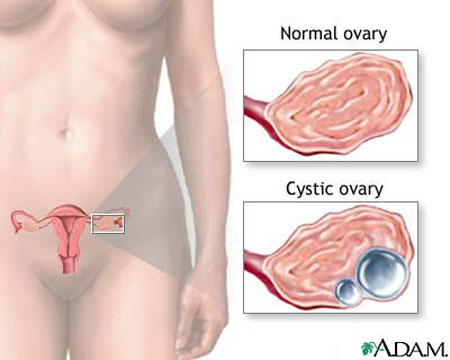Ovarian Cyst - symptoms, rupture, treatment, removal and dermoid ovarian cyst

What is Ovarian Cyst and Definiton
Ovarian Cyst is a noncancerous, fluid-filled growth that forms within an ovary. Ovarian cysts are common and many are transient (come and go). The most common type of ovarian cyst is a follicular cyst, which develops in an ovarian follicle. Typically the follicle fills with fluid. Over time the fluid reabsorbs into the follicle and the cyst goes away. Sometimes a follicular cyst ruptures, causing sudden PAIN. Cysts may also form in the corpus luteum, the structure of endocrine tissue that supports a ripened ovum. Such a cyst, called a luteal cyst, typically goes away when the corpus luteum involutes (turns in on itself) and becomes absorbed into the ovarian follicle immediately preceding MENSTRUATION. Follicular cysts and luteal cysts are usually functional-that is, they come and go with the hormonal shifts of the MENSTRUAL CYCLE. Ovarian cysts are occasionally pedunculated (growing on the end of stalks). Such cysts may twist on their peduncles and become gangrenous, which is an emergency situation requiring surgery.
Dermoid Ovarian Cyst
Dermoid cysts, also called teratomas or germ cell cysts, are much less common though more troublesome because they can grow quite large. The key characteristic of a dermoid cyst is that it consists primarily of epithelial tissue though may also contain fatty tissue and fragments of HAIR, CARTILAGE, BONE, and sometimes TEETH. Dermoid cysts are congenital (present from birth). Doctors do not know how they occur though believe they arise from cells that escape migration when the three layers of the early EMBRYO (mesoderm, ectoderm, and endoderm) develop.
Symptoms of Ovarian Cyst and Diagnosis
The doctor detects most ovarian cysts incidentally during routine PELVIC EXAMINATION or ULTRASOUND of the lower abdomen done for other reasons. When a woman does have symptoms they are often nonspecific in nature, such as abdominal bloating or pressure, CONSTIPATION, URINARY INCONTINENCE or URINARY FREQUENCY, or pain during SEXUAL INTERCOURSE (dyspareunia). Abdominal or transvaginal ultrasound or abdominal COMPUTED TOMOGRAPHY (CT) SCAN help the doctor confirm the diagnosis. When these diagnostic imaging procedures are not conclusive, the doctor may perform diagnostic laparoscopy to look at the cyst and take a tissue sample for biopsy.
Ovarian Cyst Treatment and Surgical Removal
Most ovarian cysts go away without treatment or intervention. The gynecologist may recommend surgical removal of an ovarian cyst that is large, persistent, or symptomatic (causes discomfort, irregular menstrual periods, or bleeding) or when the cyst has suspicious features that cause the gynecologist to want to rule out OVARIAN CANCER. Though ovarian cysts are not cancerous and very seldom become cancerous, they can co-exist with cancerous tumors. As well, ovarian cancer tumors commonly have cystic characteristics. Often it is possible to remove the cyst without damaging the ovary. When the cyst is large or questionable the surgeon may need to remove the entire ovary (OOPHORECTOMY). As long as the remaining ovary is healthy and functional, removing a single ovary does not affect the menstrual cycle or FERTILITY.
See also OVARIES; SURGERY BENEFIT AND RISK ASSESSMENT.
Open discussion on the topic Ovarian Cyst - symptoms, rupture, treatment, removal and dermoid ovarian cyst
Similar interests
- Nuovi Casino
- Casinos Not On Gamstop
- UK Casinos Not On Gamstop
- Casinos Not On Gamstop
- UK Casinos Not On Gamstop
- Casino Non Aams Italia
- Slot Sites Not On Gamstop
- Meilleur Casino En Ligne
- Non Gamstop Casino Sites UK
- Meilleur Casino En Ligne
- Casino En Ligne France
- Best Non Gamstop Casinos
- Casinos Not On Gamstop
- UK Casino Not On Gamstop
- Casinos Not Signed Up To Gamstop
- Best Slot Sites UK
- Non Gamstop Casino Sites UK
- Online Casinos Nederland
- Online Casinos Nederland
- Casinos Not On Gamstop
- Best New Uk Casinos Not On Gamstop